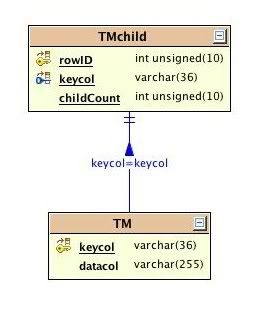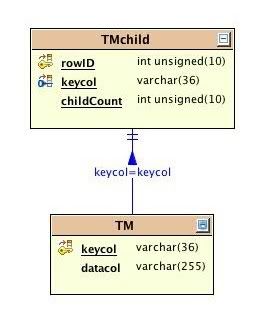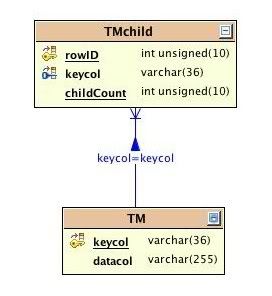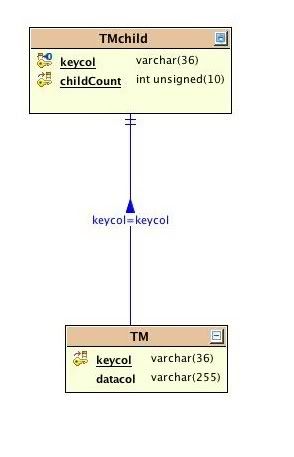For help with installation, bugs reports or feature requests, please head over to our new forums.
Genuitec Community on GitHub
- This topic has 6 replies, 2 voices, and was last updated 17 years, 9 months ago by
Sirron Davis.
-
AuthorPosts
-
Sirron DavisMemberI like to use the ERD tool for documenting my database. However, the tool regularly selects the wrong symbol for relationships.
I have many one-to-many and zero-to-many relationships which show up in the drawing as one-and-only-one.
Example.
create table TM (keycol varchar(36) not null, datacol varchar(255) not null default ‘x’, primary key(keycol)) type=InnoDB;create table TMchild (rowID int unsigned not null auto_increment, keycol varchar(36) not null, childCount int unsigned not null default 0, primary key(rowID), unique key (keycol, childCount)) type=InnoDB;
alter table TMchild add constraint fkDefn foreign key (keycol) references TM (keycol);
The above definition will show in my diagram as a one-and-only-one relationship between TM and TMChild in the ERD. Even though it is really a 0-to-many relationship.
How can I make the ERD show a proper one-(or zero)-to-many?
I am using MySQL 5.0.x and keys and foreign keys are defined in the tables.
I am using Workbench 5.5.1 GAHas anyone found a similar issue, and is there a solution?
Thank-you
January 31, 2008 at 3:41 am #281323
Loyal WaterMemberThis is the result I got when I used the tables you have posted. This is a 0-many relationship. Can you please paste a screenshot of the result you got.
Attachments:
You must be logged in to view attached files.January 31, 2008 at 10:29 am #281341
Sirron DavisMemberThis is the ERD created from the two tables. The diagram was created with a 1-and-only-1 relationship. This is supposed to be a 0-to-many relationship. I could live with this being created as a 1-to-many also. But a 1-and-only-1 relationship is wrong.
Here is the DDL for both tables:
create table `testDB`.`TM`( `keycol` varchar(36) default '' not null, `datacol` varchar(255) default 'x' not null, primary key (`keycol`) ); create unique index `PRIMARY` on `testDB`.`TM`(`keycol`);create table `testDB`.`TMchild`( `keycol` varchar(36) default '' not null, `childCount` int unsigned default '0' not null, primary key (`keycol`,`childCount`) ); alter table `testDB`.`TMchild` add index `fkDefn`(`keycol`), add constraint `fkDefn` foreign key (`keycol`) references `testDB`.`TM`(`keycol`); create unique index `PRIMARY` on `testDB`.`TMchild`(`keycol`,`childCount`);January 31, 2008 at 10:54 am #281343
Sirron DavisMemberI slightly modified the test files. This is the ERD with the files as originally posted.
I get a one-and-only-one relationship. This is not correct. It should be one-to-many.

Here is the DDL
create table `testDB`.`TM`( `keycol` varchar(36) default '' not null, `datacol` varchar(255) default 'x' not null, primary key (`keycol`) ); create unique index `PRIMARY` on `testDB`.`TM`(`keycol`);create table `testDB`.`TMchild`( `rowID` int unsigned not null auto_increment, `keycol` varchar(36) default '' not null, `childCount` int unsigned default '0' not null, primary key (`rowID`) ); alter table `testDB`.`TMchild` add index `fkDefn`(`keycol`), add constraint `fkDefn` foreign key (`keycol`) references `testDB`.`TM`(`keycol`); create unique index `PRIMARY` on `testDB`.`TMchild`(`rowID`); create unique index `keycol` on `testDB`.`TMchild`(`keycol`,`childCount`);February 5, 2008 at 5:08 pm #281482
Sirron DavisMemberI updated to eclipse 3.3 and MyEclipse Build id: 6.0.1-GA-200710
I still have the error. I regenerated and still get a one-to-one. This should be a one-to-many.
Build id: 6.0.1-GA-200710
 February 6, 2008 at 8:09 am #281497
February 6, 2008 at 8:09 am #281497
Loyal WaterMemberSirronD,
I have asked the dev team to look into this issue. I’ll get back to you with an update asap. Thank you for your patience.February 6, 2008 at 12:56 pm #281516
Sirron DavisMemberI found a work-around.
I declare a specific index on the child table for the foreign key reference. This however is not ideal as I really don’t want to define unnecessary indices in my database.
Original TMchild definition
create table TMchild (rowID int unsigned not null auto_increment, keycol varchar(36) not null, childCount int unsigned not null default 0, primary key(rowID), unique key (keycol, childCount)) type=InnoDB; alter table TMchild add constraint fkDefn foreign key (keycol) references TM (keycol);Work-around TMchild definition
create table TMchild (rowID int unsigned not null auto_increment, keycol varchar(36) not null, childCount int unsigned not null default 0, primary key(rowID), unique key (keycol, childCount), key (keycol)) type=InnoDB; alter table TMchild add constraint fkDefn foreign key (keycol) references TM (keycol);Note: The difference is in the work-around that I define an index on keycol using the syntax “key (keycol)”. This index is not required, because of the unique index on keycol + childCount.
Generated ERD using Work-around

Generated DDL for TMchild after using work-around table definition
create table `testDB`.`TMchild`( `rowID` int unsigned not null auto_increment, `keycol` varchar(36) default '' not null, `childCount` int unsigned default '0' not null, primary key (`rowID`) ); alter table `testDB`.`TMchild` add index `fkDefn`(`keycol`), add constraint `fkDefn` foreign key (`keycol`) references `testDB`.`TM`(`keycol`); create unique index `PRIMARY` on `testDB`.`TMchild`(`rowID`); create unique index `keycol` on `testDB`.`TMchild`(`keycol`,`childCount`); create index `keycol_2` on `testDB`.`TMchild`(`keycol`);Somehow the ERD generation tool is not properly identifying the relationship when the foreign key is a (high order) part of a multi-column unique index.
Many parent/child type definitions will contain only a single multi-column unique index with reference to the parent as a high-order column within that multi-column key. This parent/child relationship must be identified in the ERD as a one-to-many relationship.
And it is not practical to define a totally useless key in these child tables.
-
AuthorPosts


